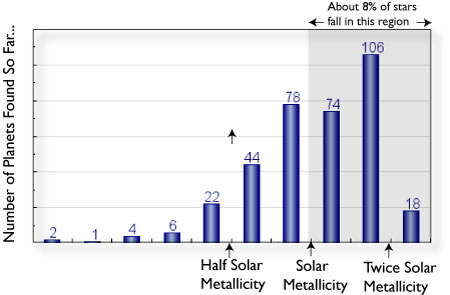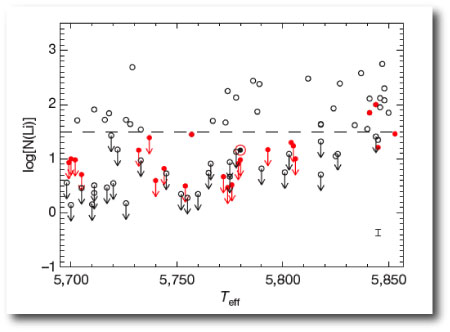
Diamond prospecting proceeds through the identification of indicator minerals such as specific forms of garnet. The garnets can be traced upstream to the Kimberlite pipes. The Kimberlite pipes contain the sparkling gemstones.
Planet prospecting can be done in similar fashion. If you want to jump-start a new planet search, it’s wise to observe metal-rich stars. Stars with more than twice the Sun’s metal abundance are roughly five times more likely than average to harbor one or more planets in the readily detectable hot Jupiter and Eccentric Giant categories. Histogrammed data from Exoplanet.eu shows the metallicity correlation quite nicely:

The metallicity correlation can be readily interpreted in the context of the core-accretion paradigm for giant planet formation. In this picture, nascent planets reach the stage of rapid gas accretion when their rocky-icy cores grow to somewhere in the neighborhood of ten Earth masses. The speed with which a core can be assembled in a protoplanetary disk is a very sensitive function of the density of solid material (e.g. ices and dust) in the disk. The density of solids, in turn, scales with metallicity.
If one explains the planet-metallicity correlation with the core-accretion theory, several predictions follow almost immediately. One expects that low-mass stars will show a paucity of readily detectable giant planets, and that high-mass stars will have a larger fraction of giant planets. Observationally, both of these trends have been shown to hold.
A less-well-known prediction is that one also expects that stars with high oxygen (and by proxy, silicon) abundances relative to iron will also show increased planet fractions at given metallicity. Sarah Dodson-Robinson showed this was true as part of her Ph.D. Thesis. Here’s the the key diagram from her paper on the topic:
![]()
A very interesting paper came out in Nature this week which shows an equally compelling, but significantly harder-to-understand abundance correlation. Garik Israelian, and colleagues that include members of the Geneva Team, write (italics are mine):
Here we report Li abundances for an unbiased sample of solar-analogue stars with and without detected planets. We find that the planet-bearing stars have less than one per cent of the primordial Li abundance, while about 50 per cent of the solar analogues without detected planets have on average ten times more Li.
Here’s the graphic from their paper. The filled red circles are planet-bearing stars. Downward arrows indicate that the measurement is an upper limit, and in all likelihood lies at a lower value. Note also, that the y-axis has a logarithmic scale, which de-emphasizes the strength of the effect. To the eye, it’s clear that the lithium abundances of the planet-bearing stars are quite low:

The effect is dramatic, and yet its origin is mysterious and seems to have gone unpredicted. It’s the best sort of scientific puzzle. Lithium is a rather fragile element, and undergoes nuclear fusion in a star when the temperature reaches ~2.5 million degrees. Lithium depletion in the atmosphere of a star can thus be taken as evidence that the gas that’s currently at the surface has, at one point, been mixed far down enough into the star for the lithium to have burned. This implies that the base of the star’s convective envelope has dipped further into the star than the 2.5 million degree isotherm. (The hot F-type stars on the far right of the diagram have very thin convective envelopes nearly right from the start, and so have been unable to burn their lithium.)
So it seems that somehow, the presence of a planetary system (and even one as wimpy as our own solar system) is enough to alter the evolution of the stellar convective envelope. This, in turn, likely has something to do with angular momentum transfer mediated by planets, but quite frankly the story isn’t very clear. Certainly, there will be papers that explain the effect, and certainly, they are being cranked out even as I write, but unless they make specific, testable, and preferably startling predictions, I’d advise taking them with a grain of lithium chloride.

Hmm.
Elsewhere it is noted that Lithium destruction takes place at the surface of the star.
Is that also correct?
Haven’t read the paper because it is behind the nature paywall. However it is interesting to note that in the 16 Cygni binary system with two sunlike stars, the planet host star 16 Cyg B seems to have approximately five times lower lithium abundance than the RV-stable 16 Cyg A.
Has anyone looked into the possibility that Li in the solar nebula dissolves into Mg silicate precipitates, and thus doesn’t get scattered or dragged back into the star?
An alternative hypothesis is that planetless stars get lonely.
Um, stellar, not solar…
Great to hear your word about the lithium connection, but I was left wondering.. where does Alpha Centauri stand in these plots?
Alpha Cen A, with an effective temperature of 5790K has log[N_Li]=1.4, which puts it very close to the Sun in the diagram on the post. Alpha Cen B has log[N_Li]<0.3, but its effective temperature falls to the left of the plot. I'm working on a follow-up post that will go into a bit more detail on this interesting question!
The HD 178911 system also shows a lithium discrepancy between the two solar-type stars, with the planet-host depleted in lithium. Large lithium discrepancies have also been noted in other solar-twin binaries: perhaps these should be surveyed very carefully for planets?
If Li depletion is due to tidal interactions, then shouldn’t binarys be as low as or lower than solo planetary systems?